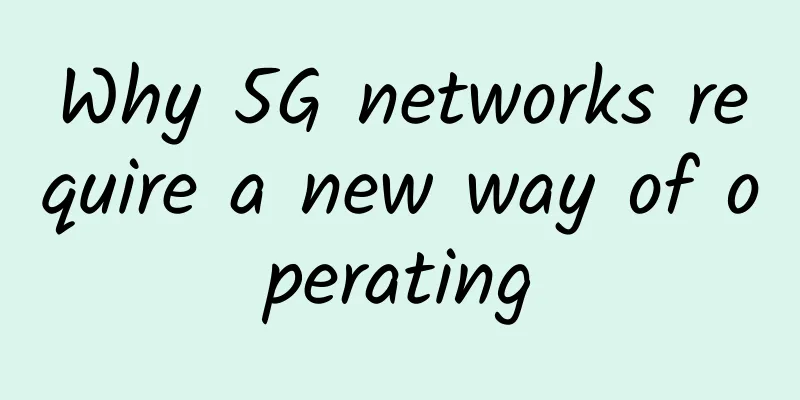Why 5G networks require a new way of operating

|
In the 5G reality, network operations are moving from reactive to predictive. But this shift is more than just switching from one capability to another. It requires an end-to-end transformation of how networks are managed, with data being the key. Learn how data is defining the future operating model for CSPs and what opportunities it brings. Why choose Prediction Network? Digital transformation. It’s everywhere and across all industries. For the telecommunications industry, the battle to stay relevant in the face of the explosion of connected devices and network operations today is in full swing, and network operations today are still largely event-driven, or in other words, reactive. However, the rollout of 5G is driving this digital transformation, which is much needed for networks around the world. Today, communications service providers (CSPs) need to address three major challenges: (1) The rise of customer experience Customer service providers increasingly support a diverse user base with specific requirements and expectations for connectivity. In fact, in a recent survey (Telecom Managed Services), 43% of customer service providers said customer service was the top reason for using managed services to solve the operational challenges they currently face. This is driving a shift toward a “customer-centric” approach to operations that places a greater focus on delivering a quality customer experience. (2) Cost-effectiveness Today’s network infrastructure is not designed to meet the growing demand for connectivity, with mobile traffic expected to grow 321% between 2019 and 2025. With the rollout of 5G and IoT, both technologies expected to drive new use cases to support enterprise digital transformation initiatives, CSPs face higher OPEX and CAPEX costs to meet this demand. (3) Stagnant income growth Global telecom revenues continue to trend flat and downward. Between 2014 and 2018, global telecom revenues for the telecom industry fell by 4%. The more mature parts of the CSP business are declining at a faster rate than new business initiatives are growing. As a result, we are seeing more CSPs partnering with media and technology companies to deliver new value streams to enterprises. This complexity will only deepen as 5G rolls out and operators can enter new industries with different business models, SLAs, KPIs and data sets. Leveraging advanced technologies to create new ways of operating networks Customer experience is a key source of differentiation. But moving to a service-centric model is about more than just delivering smooth network performance. It includes implementing a more complete data-driven approach to operations. 5G will bring revenue growth while bringing opportunities and use cases related to Industry 4.0, the development of new industries (from remote healthcare, autonomous cars and smart manufacturing) and the growth of new IoT and 5G-based enterprises that are unprecedented However, these opportunities bring with them such complex technologies that humans alone simply cannot handle the large amounts of input data required to run a network efficiently, which is why artificial intelligence, machine learning, and automation are critical technologies in network operations. It’s also why 65% of CSPs surveyed by IDC said managed services will play a major role in their transformation and overall strategy. Why? Because the new model of managed services provides an end-to-end view and a data-driven operating model that reflects the network of the future. 5G-Unleashing the Value of Data You may have heard the saying that data is the new oil, and to some extent that’s true. But it’s not just the oil itself that’s critical, it’s how you use it. For telecom operators, the ability to mine the vast amounts of data traversing the network will unlock value and drive monetization of customer content as an opportunity to optimize the network, increase network operational efficiency, and improve the customer experience. However, collecting large amounts of data (or ‘big data’) means nothing without running advanced analytics to provide network operations teams with the actionable insights they need to respond to network-related issues in a more proactive and predictive manner. The combination of AI-based analytics, machine learning and automation allows CSPs to become more agile in decision making and planning. Using big data analytics during the 5G planning phase is very important and is the first step in translating strategy into a cost-effective deployment that meets capacity, coverage and service quality issues. This allows operators to manage the evolution of the network lifecycle in a very different way, that is, by design, while optimizing the network on the same big data set. In turn, this allows the network to change and evolve at an incredible speed to meet changing user traffic patterns and growth. The creation of network slicing further highlights the need for analytics, machine learning, and automation in the network planning, design, and optimization phases of 5G deployments. Network slicing allows CSPs to create a version of the network that a single customer can use, for example, for their specific network setup – whether it be video streaming, automotive needs, or critical industry applications. Designing networks to meet the unique requirements of network slicing, while also supporting the massive and sustained traffic growth of 5G, will require accelerated planning, design, and optimization cycles, as well as the ability to enable the network to predict and prevent disruptions in real time, without impacting customers. By processing massive data sets using AI and machine learning, CSPs gain a high-resolution picture of their network, and the insights that accompany this picture enable them to pivot and adapt the network to meet the growing demands of customers and businesses. The result is improved reliability, security, and, more importantly, an improved customer experience. This data-driven approach is key to a trusted operating model that will better position CSPs to meet the future needs of their customers. However, today, many CSPs lack the resources or skills needed to fully leverage the advanced technologies available to truly transform their network operations. That’s why we’re increasingly seeing CSPs partnering with technology companies. CSPs are recognizing the value of working with trusted advisors to add value to their revenue streams. As 5G rolls out, we’ll see a security partner with the knowledge, experience, and capabilities to leverage data alongside CSPs. Collaboration is key We are transitioning from a world where industries manage technology to one where they deliver experiences. If CSPs are to keep up, they also need to develop new skills and ways of working to become true digital service providers. People often worry that technology will make today’s jobs redundant. I disagree. With the right predictive processes in place, human ingenuity and creativity – something that technology lacks – can be used elsewhere in the business. Focus can be shifted to other areas of interest and further enhance the customer experience for users and services. For 5G to truly have the expected long-term impact, we need a different way of operating. Simply having access to data is not enough. CSPs need to adapt to a data-driven organization - combining a new skills approach with a collaborative operating model to fully prepare for future connectivity demands. |
>>: Qualcomm: The invention of these key technologies has driven the expansion of 5G!
Recommend
Huawei launches the "Bo Le" mode: Interesting souls should show off in the Future Application Creativity Competition!
[51CTO.com original article] Technology has been ...
Cloud desktop helps Internet diagnosis and treatment to accelerate!
On August 27, the "Sincerity, Diligence, and...
SmartHost: $4.95/month KVM-quad core/8GB memory/40GB NVMe/2TB monthly traffic/29 data centers available
SmartHost recently offered special discount codes...
Taking stock of Internet companies that have deployed blockchain: Is blockchain a "panacea" or a "scam"?
Bitcoin was launched in 2009. As the price of Bit...
RAKsmart New Year Event: E3 servers starting at $30/month, 30% off on all VPS, popular VPS starting at $1.99/month
RAKsmart is a foreign hosting company operated by...
IKIHOST: $3/month-AMD Ryzen/2GB/30G NVMe/Unlimited traffic @10Gbps/Salt Lake City Data Center
This is the first time that IKIHOST has appeared ...
If IT operations and maintenance fail to do this, congratulations, you will be blamed for this.
When it comes to IT operations and maintenance, m...
Cloud Base: Los Angeles CN2 GIA high-defense server, 50-500Gbps defense/ignore CC, fast listing
Yunbase is a Chinese hosting company. The domain ...
Make network management more efficient! Quickly scan the LAN and obtain IP and MAC addresses in real time
Have you ever received a network failure alert la...
Moderately advance the high-quality development of 5G
This year's "Government Work Report"...
Tencent Cloud 618 Procurement Season, 2C4G6M lightweight server starts at 128 yuan/year, 2C2G4M starts at 18 yuan for three months
We participated in the preheating and received co...
Easy to understand, this article will introduce you to the HTTP protocol?
1. What is http? Http protocol is Hypertext trans...
Telecommunications industry survey: AI will become the top investment area in 2025
In the 2024 annual industry survey conducted by T...
Patent empirical analysis of opportunities and challenges in China's development of 6G communications
Compared with 2G communication network, 3G realiz...









